
The Birth and Return of Christ and the Celestial Sphinx
Eleven years ago, in a study on the Try-God.com website we proposed a thesis that the Great Sphinx was originally intended as an oracle of the promised seed and the Messiah. Both Herbert Lockyer and Frances Rolleston have stated, that the Great Sphinx symbolizes the Summer Solstice 4000 years before Christ, sealed by the union of Virgo and Leo. Rolleston notes that this junction of Virgo and Leo is marked by the star Denebola, the namemeaning “the Lord or Judge who comes quickly,”1 thus representing a living image, of the Lord Jesus Christ coming in judgment. As the star marking the unity between Virgo and Leo, the alpha and omega signs of the Biblical zodiac, this prophetic messenger of the coming Messiah has endured as the largest, and oldest colossal sculpture of renown on the planet.
Figure A. The Great Sphinx
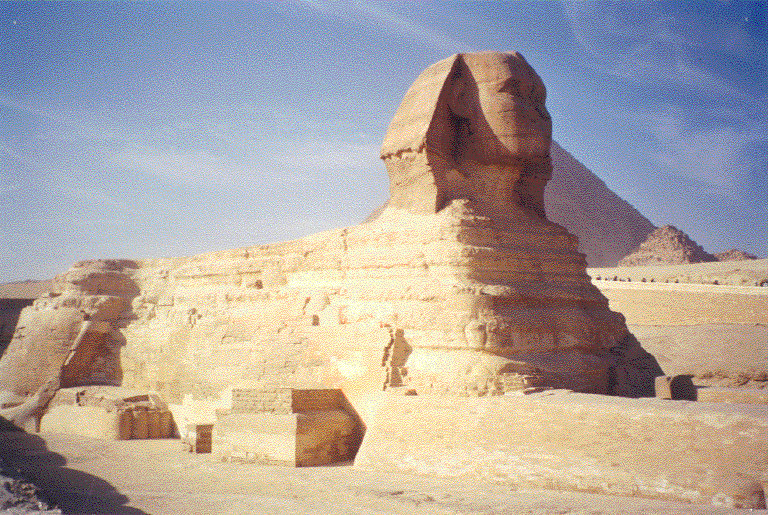
This monument to the promised seed carved out of the Giza plateau, has stood for ages facing east, envisioning both the first and second advents of the Lord Jesus Christ. As the imperious sentinels of Giza, the Great Sphinx and the Great Pyramid are the foremost ancient monuments, having stood the test of time, foreshadowing the Second Coming of the Son of God as no other landmarks in human history. These great surviving wonders of the ancient world have remained singularly poised, high above the barren shifting sands of human ignorance, safely founded on prehistoric bedrock of truth, prophesying of the coming promised seed, in harmony with the witness of the Stars and Scriptures. Their combined declaration sounds out from the geographic center of the Earth’s landmass, ever ringing upward in concert with the testimony of the celestial luminaries. These monolithic monuments of the Giza plateau, the Great Pyramid and the Great Sphinx, serve as prime examples of our thesis, showing the roots of what Joseph Campbell called the world monomyth , the idea that all the world’s myths are rooted in one master overarching epic narrative. I believe as others have before me, that this master myth has celestial roots, and these roots ultimately lead us to the divine Astronomy of the Biblical Patriarchs, Adam, Seth and Enoch. The following introduction to the Great Sphinx, from a Biblical Astronomy viewpoint, will serve as important step along this path of understanding. During recent posts on our Blood Moon Blog we have surveyed the Biblical Astronomy of the heavenly signs surrounding the Birth of Jesus Christ, where a number of aspects linked to the Great Sphinx have surfaced, which are summarized in the study of The Great Sphinx @www. Try-God.com, [read more].
Our review of the heavenly signs surrounding the birth of Christ gave us an introduction to some unique aspects of the Great Sphinx, which we will expand on in this study. A consistent indicator marking the heavenly signs bearing the celestial seal and signet of the Great Sphinx, is that most of these heavenly signs occur during the 3-week annual period when the Sun is clothing Virgo, [Rev. 12:1]. This is relevant due to its symbolism of the genuine exaltation of Mary, the woman who was most highly blessed among women, because she believed the words of the archangel Gabriel when he told her she would bear the promised seed. We have made past references to the dual significance inend times
prophecy in [Rev. 12:1-2] as it relates both to the sufferings and glory of the Lord Jesus Christ, in his 2-fold ministry to present his kingship to Israel, that was rejected 2000 years ago, and now is being revisited as we complete the Blood Moon Tetrad of 2014–2015 with the heavenly signs presaging his glorious Second Coming to install his kingdom of everlasting righteousness and peace. The graphic below depicts Mary crowned with the 12 Stars/Tribes of the Hebrew Zodiac [Gen. 37: 9-11] holding the infant Jesus, with the Crescent Moon at her feet. Here Jesus embodies the Sun clothing Virgo with the Moon at her feet as seen on Sept. 11th, 3 BC in the heavenly signs marking the Birth of Jesus Christ. Modern stargazers have struggled to fit the crown of 12 stars around Virgo’s head, with the heavenly signs marking his birth and Second Coming, but as Gen. 37 tells us in Joseph’s dream, the Sun, Moon and 11 Stars bowed down to Joseph as his 11 brothers bowed at his feet in Egypt, fulfilling his dream. Both the Great Sphinx and Joseph’s Dream show the 3-fold Solar, Lunar and Stellar aspects of the Hebrew Calendar, and as we view Virgo Crowned with the 12 Stars/Signs/Tribes of the Hebrew Zodiac in the context of the Great Sphinx, the truths of the Celestial Sphinx come into focus.
Figure B. Mary Crowned with 12 Stars holding Jesus with the Moon at her feet.
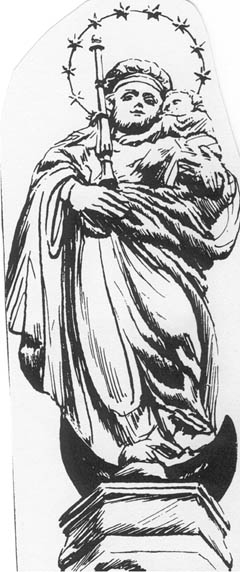
In addition, the Sun in Virgo usually coincides with the annual start of the Hebrew Civil Year, opening the month of Tishri. As we have pointed out in recent Blog posts, the Feast of Trumpets opening the month of Tishri is marked by a Partial Solar Eclipse on September 13th this Fall, even as the opening of the sacred year/Nisan 1 is marked with a Total Solar Eclipse on March 20th, the Spring Equinox, followed by a Blood Moon Lunar eclipse two weeks later at Passover. Thus from the inception of the heavenly signs linked to what I have called the Celestial Sphinx, the fact that these notable heavenly signs take place on, or during Hebrew Feasts and holy days, is also a key indicator, even as it has been throughout the Age of Grace relating to the Blood Moon Tetrads, over the last 200 centuries. Another prime aspect of the heavenly signs linked to the Celestial Sphinx is that we find unique planetary conjunctions that took place marking the Birth of Jesus Christ, in the constellations Virgo and Leo. Since these are the zodiac signs that constitute the alpha-omega signs of the Hebrew Zodiac, forming the Celestial Sphinx, it provides a living practical example of Biblical Astronomy which the Great Sphinx itself memorializes. As a central example of Biblical Archaeo-Astronomy, the Great Sphinx is a true living artifact of the divine science of Biblical Astronomy that the Creator utilizes today, marking the heavenly signs of the Second Coming of His only Begotten Son. In this light, we take note of the relief from the ceiling of the Temple of Esneh;2 [Fig. C], where the basic stellar figures of Virgo and Leo are unified in the Great Sphinx, pictured with the solar disk crowning the head of the woman-“sun clothing Virgo,” who is joined with the body of the Lion, above the serpent Hydra. This clear stellar image found at the same temple site housing the Dendera zodiac, provides strong archaeological support, not for the union of Virgo and Leo only, affirmed in the two stellar aspects of the Sphinx monument, but also the exaltation of the woman-Virgo. She is pictured at the far right below, prominently holding her grain stalk, or branch [Al Zimach] as she is shown in Dendera’s zodiac, symbolizing her bearing the promised seed, the light of the world. This is a key point in the history of Biblical Archaeo-Astronomy, since the Dendera Zodiac is another central piece of archeological evidence in our Biblical Astronomy narrative. This will be the topic of future posts on our Blood Moon Blog.
Figure C. Ceiling Relief from the Ancient Egyptian Temple of Esneh
|
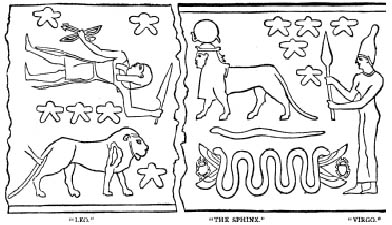 |
This sets the basic context of the original function of the Great Sphinx, including:
- The unity of the Biblical zodiac which starts at Virgo and ends in Leo, summarizing the truths of Biblical Astronomy and Archaeo-Astronomy.
- The original role of the Sun in this context of “clothing Virgo,” along with embodying the solar aspects of the Sphinx as the Son of Righteousness.
- A Stone monument memorializing these truths parallel witness to the Coming Redeemer found in the Stars and in Scripture.
With this in mind, lets look at some specific stellar aspects of the Great Sphinx.
Stellar Elements of the Great Sphinx
There are at least three categories of Celestial Sphinx signs. The first is in a class by itself, that we find in Figure E. Here, the head of the woman Virgo, clothed with the sun is rising above the horizon as seen from Jerusalem, with the full body of Leo the Lion, already risen. As a marker for the birth of Christ highlighting these two major components of the Great Sphinx, this sign certainly is worthy of our special attention. A second category of signs along these lines is seen also when the Sun is clothing Virgo. During this time of year, a period of about 20 days length, if planetary unions occur in both Leo and Virgo, the two stellar aspects of the Celestial Sphinx are thus highlighted. An example of this was seen in the signs surrounding the birth of Christ, from September 9th to the 14th in 3 BC. Figure E shows the first of three conjunctions of Jupiter and Regulus in Leo first visible, as the heavenly signs marking the birth of Christ took place September 11th, in Virgo. The original teaching of the witness of the signs of the zodiac is encapsulated in the zodiac signs Virgo and Leo and preserved in this ancient monument of the Giza plateau, the Great Sphinx. An interesting astronomical truth in support of this lies in the fact that the crowned head of Virgo actually bridges about 10 degrees into the sign Leo on the ecliptic. We have already made reference to this in connection with the star Denebola. The star Sarcam in Leo, is a Hebrew word meaning “the joining,“3 identifying the point where the two ends of the Zodiacal circle have their joining. This is borne out in the sign Corvus, the bird of prey devouring the sea-monster Hydra, a decan of Virgo. The bright star in the eye of Corvus the Raven, called Al Chibar in Arabic means “joining together,”4 referring also to the union of as these two ends of the true zodiac! This is pictured in Figure D. below, depicting the Hydra a major sea-dragon constellation [Isa. 27:1], with Corvus the Raven and carrion eater, shown devouring the perishing remains of the destroyed Serpent. This is the enemy’s destiny which we also find pictured in the Temple of Esneh above, with the serpent under the Lion’s claws.
Figure D. The Constellation Hydra; the Serpent destroyed.
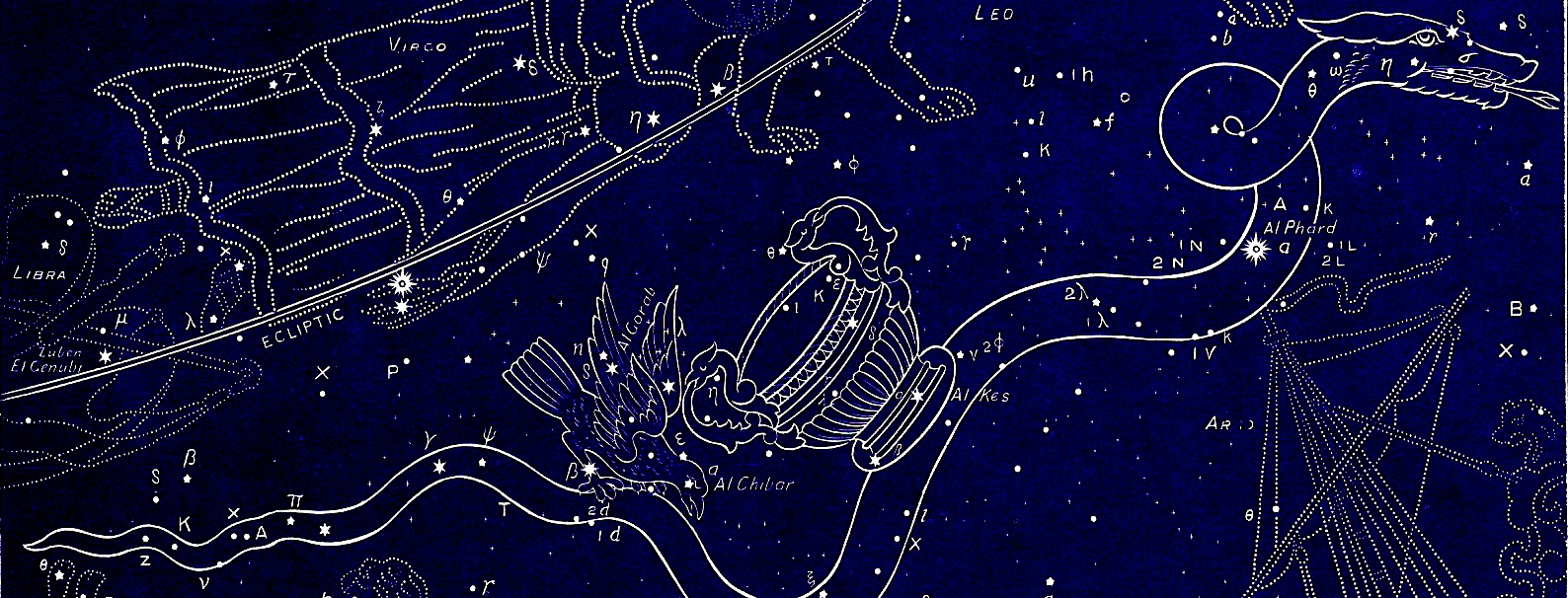
This also fits with the start of the Hebrew calendar in Tishri, the equivalent of our September-October, the beginning of their civil year when the Sun was clothing Virgo. As we have seen in previous posts, the heavens announced Jesus’ arrival with the setting of the star Spica, Virgo’s branch on our September 11th, of 3 BC. In addition to naming the start and close of the celestial canon, the Great Sphinx mirrors the binding of Scripture together from Genesis to Revelation, as seen in references to Jesus as the Lion of the tribe of Judah in both Gen. 49:8-10 and Rev. 5:5, the first and last books of the Bible. Another indicator of the central importance of these stellar aspects of the Great Sphinx, is that our recognition of the Celestial Sphinx, pictured below, Virgo and Leo the lion provide the basis for the signs of the triple union of Jupiter-Regulus in Leo, in 3 BC related to Gen. 49:8-10. This is a foundational key linking the Great Sphinx both to the witness of the stars and Scriptures, in their unified testimony to the Coming promised Seed. As we view the celestial context of this first union of Jupiter and Regulus, [Fig. E] we can see the head of Virgo rising above the eastern horizon just below the full body of Leo the Lion on the ecliptic. This is the view of what an observer standing near Palestine facing east would have seen on this date, providing a clear aspect of the astronomical symbolism of the Celestial Sphinx as an important marker and monumental prediction of Jesus’ birthday on September 11th, a prophecy of the birth of Christ preserved in stone from antiquity! Thus, the Great Sphinx stands as Giza’s defiant sentinel, having weathered hundreds of centuries as a witness and messenger of both the canon of the celestial scroll of God’s Word engraved in the heavens, a prophesy of the birth of the Son of God. Always facing east, the Great Sphinx anticipates the truth of the Son-rise of the ages, whose eastern light is the long awaited dawning of a new day for all Mankind. As the subject of our last two February posts, this Eastern light through the Tabernacle is reflected spiritually in the Tabernacle/ Temple ministry that Jesus Christ fulfilled as the High Priest after the order of Melchizedek, even as we see it in the Creator’s celestial order, as the Sun travels its annual path through the 12 houses of the ecliptic, daily rising in the east. This is a theme that arises again in relation to The Celestial Symbolism of the Tabernacle and Temple of Israel, [read more] This serves as a monolithic marker to the prophecy provided in Rev. 12:1-5, in the sign of Virgo, further establishing the dual significance of this prophecy foretelling of the First and Second Advents of the Lord Jesus Christ.
Figure E. The Celestial Sphinx.
The Head of the Woman and the Body of the Lion as seen on Sept. 14th, 3 BC, on the eastern horizon from Palestine, forming the aspects of the Celestial Sphinx, marking the first Jupiter-Regulus Conjunction in Leo.
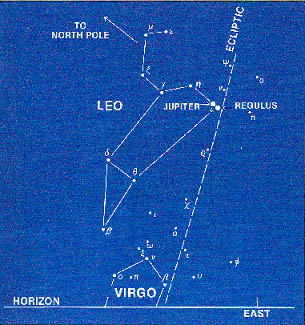
We find these landmarks at the head and tail of the zodiac, which adds light to Dr. Martin’s observation that: “the woman Virgo is the Constellation of Headship for all twelve signs. The head position of Virgo is located within the last 10 degrees of Leo.” Virgo’s head is seen in Fig. D, just below and adjacent to the star Denebola in the tail of the Lion, unifying the circle of the zodiac. When viewed in context with the witness of the Great Sphinx, this sign on 9-14-3 BC takes on added meaning, indicated in the Sphinx’ two basic elements. These two elements are detailed in the movement of the King planet Jupiter entering Leo, the lion-body of the celestial Sphinx, while the Sun was in Virgo, the female head of this Sphinx. As the stars are allowed to speak in harmony with this witness in stone, the solitary guardian of the Giza plateau anticipates the dawning of a new day for mankind, as it predicts the birth of Spica, Virgo’s promised seed. Thus, the Great Sphinx and the Great Pyramid stand, as oracles, monumental prophets of both the Alpha and Omega, the first and second advents of Jesus Christ, revealing both his sufferings and glory. These stellar aspects of the Sphinx, are reinforced by the picture of the eastern horizon during the early morning hours of September 14th, at the time of the first Jupiter-Regulus union. This distinct star picture of the Head of the woman Virgo rising above the horizon, with the body of the lion above, initiating the first of 3 Jupiter-Regulus unions, aligning the prophecy of the stars with the Scriptural prophecy of Genesis 49:8-10 is definitive evidence for our thesis. This triple conjunction of Jupiter-Regulus in Leo was bracketed by the two Jupiter-Venus conjunctions also in Leo between August 31st, 3 BC and June 17th 2 BC. This June 17th, 2 BC conjunction of Jupiter and Venus the bright and Morning Star, was a most notable and attention grabbing heavenly sign marking the birth of Christ.
Figure F. Leo the Lion
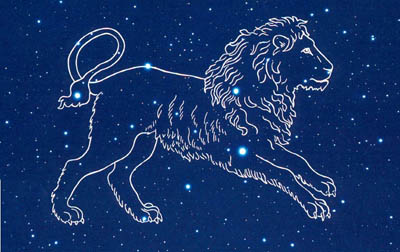
The major signs marking the birth of Christ on September 11th 3 BC, are not only sealed with this triple union of Jupiter-Regulus in Leo, but also by this singular Jupiter-Venus conjunction in Leo on June 17th of 2 BC. In addition the greater majority of heavenly signs marking the birth of Christ were bracketed by 2 Jupiter-Venus unions in 3 and 1 BC. The first Jupiter-Venus Conjunction marking the birth of Christ took place on August 31st 3 BC, in Leo with the last one occurring on August 21st 1 BC, in Virgo. Here we find an interesting variation on a Celestial Sphinx sign highlighting planetary conjunctions of Jupiter-Venus, that took place during the first fulfillment the Rev. 12:1-2 prophecy relating to the sufferings of Christ in his ministry as the Passover Lamb. This alerts us that we should look for similar Celestial Sphinx signs as a precursor to the Lord’s Second Coming. The fact that there were also two Venus-Mars conjunctions bracketing the central Jupiter-Venus union between March 31st, 2BC and Dec. 9th, 2BC, marking the birth of Christ, sets a precedent that we will see in similar fashion leading up to the Lord’s glorious Second Coming. In this light, it is with great interest that we discover between the two Venus-Mars conjunctions of 2015, that 3 Jupiter-Venus conjunctions will occur in Leo, followed by Jupiter-Venus conjunctions in Virgo in both 2016 and 2017.
The following dates will see Jupiter-Venus conjunctions in Leo in this Hebrew Jubilee year of 2015:
June 30th, 2015
August 25th, 2015
October 26th, 2015
The following dates below, will see Jupiter-Venus conjunctions in Virgo in 2016-2017:
July 27th, 2016
Feb. 26th, 2017
Nov. 13th, 2017
These modern heavenly signs of the Celestial Sphinx are manifesting before our eyes in the last days leading to the victorious Second Coming of the Lord Jesus Christ, informing us in no un certain terms that the end is near. As the rewind of heavenly signs of Christ Jesus’ first appearance on earth occur in the context of the present day Blood Moon Tetrad, including the upcoming Passover Blood Moon on April 4th, the celestial warnings of the Second Coming are undeniable to those with eyes to see and ears to hear… Are you ready?
Footnotes
1. Gospel in the Stars, Joseph Seiss, ppg. 133-134
2. Witness of the Stars, E.W. Bullinger, p.21
3. IBID, p. 165
4. IBID, p. 169